First of all who was the blogger, it was me of course and this is my story on how this all took place. If you are not familiar with “Reputation Restore” you can search it on the internet and find many companies who will provide this service for you if you feel you have been slammed with bad publicity on the internet or just want to hide what is out there. You will find quite a few pages with companies that advertise on the web and run a business to fix your reputation. Here’s a screenshot of what a simple search turns up. As you can see there are a lot of folks out there offering to fix your reputation on the internet. 
I won’t get into the specifics of it here yet but if you watched 60 Minutes a couple weeks ago and heard the story about the Duke Cancer Clinical Trial, at the very end of the story they mention the doctor who created the false information was found on the internet, practicing in another state and they mentioned “Reputation Restore” was used. New information about the doctor was created on new websites to show a more favorable side of the doctor. In case you missed it you can watch the video at the link below where I covered the story and added it to my series on the Attack of the Killer Algorithms as Chapter 15.
I’m a Healthcare blogger that has been around for about 5 years now on the internet and the name of the blog, Medical Quack sometimes attracts attention by tags and keywords that may or may not be relative. This seems to be happening quite frequently today as free text is being mined and searched for words that can bring relative information of value to various posts I have. Everybody gets this today with search engines and aggregation of data.
Sometimes using such methodologies can create some very surprising results too and in my case with Reputation Restore, it created a ton load of spam. Anyone who blogs today pretty much uses their “spam” filters, and I do too so spamming comments are not allowed to “auto populate” on my blog posts; however the spammers are still alive and well out there and keep trying. I get an email notification on every comment so this way I can approve the comments and this is done to keep the spamming commenters out. When you see such comments you can easily recognize them as they are comments not relative to the topic at all and usually contain a link that advertises something or is a link to promote their own site.
I have other healthcare bloggers who post and have a link back to related material they have, it’s not a problem for me to allow those as it is good sharing of information and I do encourage that; however, when the unrelated and  easily recognized spammers hit, again I don’t want those and neither do my readers want to see such clutter either.
easily recognized spammers hit, again I don’t want those and neither do my readers want to see such clutter either.
The commenting is also done to create links back for SEO purposes as well and if you read the news last year both JC Penney and Overstock were a couple of the companies busted by Google for using text links to move their ranks up higher in the search engines. They were both put in the penalty box by Google for a while and then once fixed they were back out again. What was also interesting about this though was a few months later Google was challenged on their own policy with such links. The whole idea here is too keep things fair and not allow certain companies and websites to monopolize search engine results and rank at the top unfairly as I see it.
Now back to the story line here and as a disclosure I don’t’ own any stocks and thus have no ties one way or another to anything in this story other than the fact that I do a website that helps give small cap companies exposure. I am a 1099 webmaster here and they are a publishing website so I wanted to put this out front so there’s no confusion there with the sponsor of my blog.
Ok so here goes…about a year ago my spam filters and email notifications one day started going crazy. When you do a blog you have few comments that come in every day and depending on the size and circulation of your blog it varies but when you get about 20-30 from the same source in a matter of 15 minutes coming in, you go look. My first thoughts were that someone was trying to game the search engines and was placing a number of links on my blog posts.
Again these are all non related topic “generic and canned” comments that an algorithm created. I have had these before but not quite this heavy as they continued on for a number of days. 20-30 blog comments each time were being sent to my blog. It would stop for a couple days and then about 2-3 days later, the next rush of spam comments would fill up the spam filter and my inbox notification system. Well after a few days of this I decided to check into this as I had not seen anything as persistent as this and the fact that every few days more loaded up got my curiosity going.
In looking at the spam comments I noticed that all of them contained links and they went back to the same 10 to 20 websites and decided to do some looking around. They were comments all made by Lindsay Rosenwald that had links back to other websites. Well needless to say I got an education in this process and found some very interesting websites and some that are very quirky, which are known as “splogs”. If you have not heard that term before this is a new word that was created to be a merge of the words spam and blogs which means these are not in fact “real” blogs but rather aggregated material from various sources. Lindsay Rosenwald is a Biotech related Hedge Fund manager and all of these comment links lead me back to the splogs.
Now upon finding these “splogs” I decided to do a search to see if they came up in general searches, and guess what, they did. They are easily recognized as the “splogs” all have very similar names so if you spend time searching the web enough you see patterns. Here’s an example of one of my notifications I had in my inbox. You can read the comment and clearly see that it was created by a “bot” just by the content. I had a bunch of these.

It looks like the “splogs” were updated since the comments in April. By following the  link I find out that he has a hedge fund called OpusPoint Partners. How does one know this is a “splog”…one look at the blogroll tells all as all the past articles have the same title…his name…
link I find out that he has a hedge fund called OpusPoint Partners. How does one know this is a “splog”…one look at the blogroll tells all as all the past articles have the same title…his name…
Ok so in searching this link from April of 2011 and finding a link to a September 2011 updates, this tells me the “splogs” and Reputation Restore seems to be alive and well and occasional updates have been made. The good thing though is that I didn’t get “spammed” again with 20-30 comments this time as back in March and April of 2011 I had over 200 spam comments, all just like the screenshot above.

Ok so looking at this splog a little closer I see several categories here and decided to poke around a bit and see what’s there as we have Mystery, Romance and Adventure posts here to see. At the bottom of the page is an advertisement stating the page was done by SRS Solutions a marketing firm. The romance column is hysterical as you can see this is “filler text” and I wonder if anyone else besides me was curious and read this? Here’s a small preview of the filler text, again all arranged and put in place by some algorithm bots…kind of funny…and I don’t know what novel or book this came from but random text as filler (enjoy) …and see how the algorithms put his name in place in selected tag areas with links back to other “splogs”. In reading this I am thinking if perhaps his wife saw this? If she didn’t know a lot of questions could come about <grin>, but we all know this is filler text created by an algorithm.
“No matter how much she hung around him, she couldn’t help but stare – not at his well toned physique, not at his startlingly blue eyes, not at his near transparent blonde hair – but at his perfectly straight teeth, as bright as polished white marble. Normally she had to stop herself from watching him quite this intently, but “the guys” (Michael, Ryan, and Wes) were all occupied. Michael was in the kitchen, where he meticulously topped off three shot glasses with smooth, amber-colored tequila. Meanwhile, Ryan and Wes in the other room.
Stacey pried her eyes away from Lindsay Rosenwald, the man she kept staring at, and looked at the blank white ceiling for a moment, startled to realize that it now seemed off-white compared to Lindsay’s teeth. The white was a strange contrast to the eight-decade old wood paneling that covered all the walls. Stacey slouched back into the couch – which was mostly a khaki color, though marked artistically with various chocolate, rum, and soda stains. The couch was easy to sag back into; Stacey gave in to the sensation of being devoured by the plush micro-fiber fabric.
Lindsay Rosenwald took a gulp of his beer then lifted it into the air in a mock salute and said “I’m lame.” Stacey laughed, and Ryan jokingly flipped Lindsay off.
As the guys started doing shots (yelling inappropriate words before each one) Stacey stood and silently went into the bathroom, turning on the light and closing the door behind her, leaning against the counter. She started looking herself over in the mirror.
In the back of her mind, she knew she was checking how she looked. Checking to make sure she looked like the cute girl-next-door that she had always been labeled as. She knew she was making sure because of the unspoken temptation in the back of her mind. A temptation she had completely resisted during the two years that Becky Fullmer and Lindsay Rosenwald were together, but that was getting harder and harder to ignore.”
Going back to the home page on this particular “splog” we see that Mr. Rosenwald has his hedge fund discussed and also has some other pretty high credentials to his name as well, such as his involvement with Cougar Biotech and selling the company to Johnson and Johnson last year and this bit of information below.
“Rosenwald has had an extensive career in managing investment funds, most notably for the Aries Fund (1994 – 2007) and the Orion Fund (2002 – 2006.) Both of which are highly regarded. In the year 2000 under the overseeing of Dr. Rosenwald the Aries Fund invested a substantial one billion dollars into healthcare.”
Dr. Lindsay Rosenwald partakes in many other activities outside of his professional career at OpusPoint Partners, most notably he sits as a member of the Board of Directors in the Republican Jewish Coalition. Though maintaining his thriving business is his main goal, he foresees its continued growth and works diligently to expand and preserve his solid contacts in the biotech and life science financing industry.”
When you follow some of the links, you are lead to even more “splogs” and again you can see where the algorithms mess up with formatting text…like here…you find the same text over and over and again in some areas the algorithm really messed up <grin>. Utah SEO is another company listed at the bottom of the sites for producing some of these. I would call this a rogue algorithm here that got a little out of control and we read this happening to in the stock markets and a company called Nanex is very good at reporting these incidents with great images, but this is one little algo who couldn’t spell or follow formatting rules.

Here’s another “splog” page and again all the past articles have all the same titles..wild stuff!
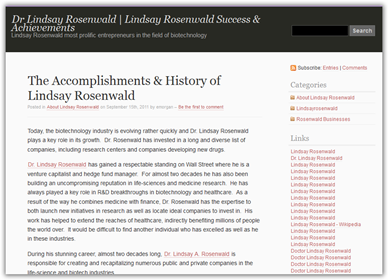
Coming back around here I would have probably cared less and never would have seen any of this if it were not for the big spam attack on my blog. When the company did the “Reputation Restore” process it was probably not a good idea to hit a rather well read healthcare blog like mine, you think? Did they check that out, obviously not. Here’s yet another spam comment, again one of a few hundred that infiltrated my blog, so I went to go check out this link that goes way back to the New York Times in 1988 and talks about his Director of Finance appointment at D.H. Blair. Well before I read this link I didn’t know who or what D.H. Blair was but after reading several of these links I thought this was some of the content that was maybe meant to be hidden or buried? Keep on reading…
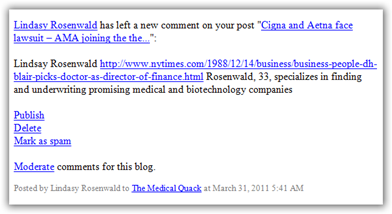
Ok so now my curiosity is aroused to find out what is D H Blair since this article was so old and was obviously put in there for folks to read, right? So let’s go see what a search turns up here. This is what shows up with a search…OMG Bernie Madoff? We all know who that is, so I decided to do some reading as I do a lot of that but now I’m curious and boy what a reading file Google pulled up for me. I also looked at Google images via a search and he was the first picture that came up. Actually it was a good thing that my spam filter caught a lot of the comments as more of my Medical Quack readers may have done some additional reading.
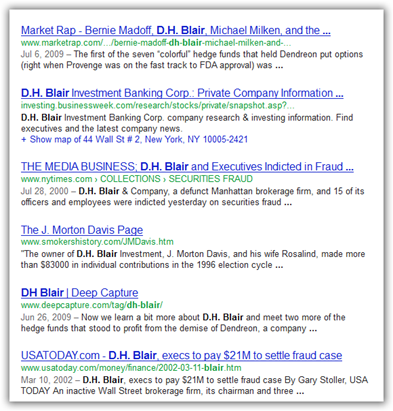
Ok so now it’s starting to set in as to why this Reputation Restore campaign might exist as I begin reading? From what is published on the web, there’s a lot of players here and again I don’t know any of these folks here and didn’t know any of this, but I do now after being spammed. Shoot this was more reading than I bargained for in just my small pursuit of finding out who spammed me! Let’s dig around and check out another spammed comment shall we.

So I followed this link and found yet another so called “splog” and checked it out. I found out he was a Republican and part of the Republican Jewish Coalition as a member of the Board of Directors and there’s a video at the splog that references the other “splogs”..and it was done in March of 2010 but it looks like they have his age wrong in the comments at stating 76? It was created by this firm it states under the comments. Looks like a bunch of bad algorithms to me.
If you look around under similar videos that appear we seem to have the same video created by SEORouters here and another one here and yet one more here that dates back to the same time when I was being spammed.
The only half way decent page linked in all of this is Wikipedia but guess what, I found different links and some other artifacts such as the New York Times paper article from 2008 stating he had been offered $85 million for his penthouse in New York and again the sale of Cougar Biotech to Johnson and Johnson. What I also found interesting on this page were the “dead” social network links, in other words they don’t work and take you back to the home page.

Needless to say this is the work a a ton of “bots” to say the least. Anyway getting back to the search I did above now I’m reading Deep Capture, Market Rap and a ton of other archived articles which I probably would not have known existed otherwise:)
So the question here is what purpose has the Reputation Restore accomplished? Did this Hedge Fund manager get taken for a ride on his money spent? I am guessing he did spend some money on this project as these folks would not work for free with creating and running these algorithms.
With all the wealth and money I wonder what he was sold on the job this company did and why the bots used were so “not good” as they connect to “splogs” and when you look at the examples you can see what is out there. Let’s go one more step and see what Google has for searches that are related…and here it is…

We come right back around to D H Blair again for one and Madoff, along with a few others added in there. Guess what, I get a lot of the same “splogs” again and a few other tidbits and this time the Market Rap and Deep Capture results are at the top, (which I am guessing is the portions meant to be buried in searches) so what is this campaign doing besides making a mess out there? The You Tube videos in the splogs have little play so hardly anyone is looking at those either.
This even gets better as when you do a search for reputation restoration there’s even a link on the Deep Capture page where a company wrote a story about this and is probably looking for new business. What I did learn by reading is that Deep Capture did not profile Mr. Rosenwald very favorably and again Deep Capture has their own naked short selling tale to tell and who knows what the whole story is once it all comes together. Now in my travels around searching Google I ran across a few other blogs with the same “spammed-canned” comments, like this one. My spam catcher caught mine but no back links from the Quack to the splogs which doesn’t do anything for “splog search engine optimization” <grin>.
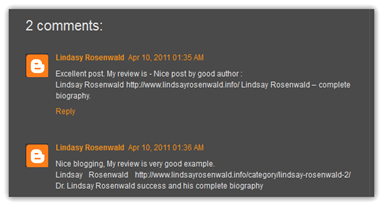
Also this came up in a search, a comment that is exactly the same as the posts on the “splogs”…at a reverse merger page back in 2009…
http://www.reversemergerblog.com/2009/08/08/cougar-biotech-wow/
Here’s yet another one by a blogger called “Noel Vega” and yup it’s all about Mr. Rosenwald and is yet one more splog it appears. Actually I was not the first site to notice this activity as a site in Germany (which I don’t know if they were spammed or not) figured it all out too. Below is what that site had to say as he linked right over to the Deep Capture site, which by the way is published by the CEO of Overstock.com. He did a pretty good job as describing the whole lot of web sites.
Real-Life Reputation Management Example
“These are all simple WordPress installs with a few articles. It’s pretty obvious they’re only here to occupy the first page on Google.
As soon as you dig deeper into the SERPs (search engine results pages) you’ll find tons – and I mean TONS – of web 2.0 properties linking and pushing his WordPress sites and the EDU profile among others”
“Lindsay Rosenwald may be the son-in-law of “the king of stock fraud.” And he was once the vice chairman of D.H. Blair, a firm affiliated with the Mafia – a firm that was run by two former top lieutenants of Michael Milken before it found itself at the center of one of the biggest Mafia investigations in the history of the FBI and on the business end of a 173-count federal indictment.”
In some cases the splogs even spam themselves with comments such as here…
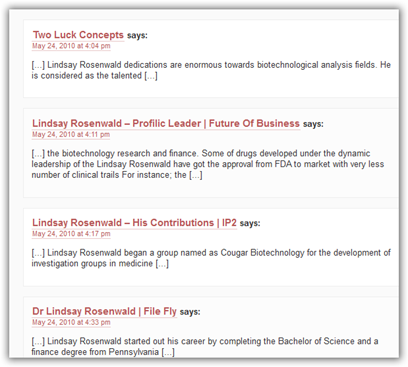
And there’s some links back to some cached pages of Cougar Biotech floating around out there which we know now was purchased by Johnson and Johnson mainly for their prostate drug which is now on the market.
It sure looks like he got soaked on this deal on repairing his reputation as with browser and search changes  made by Google and others, all it appears to be doing now is stuffing the web full of spam and again I would not even be aware of this if who ever they hired knew what they were doing and wouldn’t have spammed my blog so badly. You know we hear in the news all the time about money not matching up or they can’t find it, like Corzine and no wonder if the big guys at the the top get sucked in by folks like this who did this some what make shift reputation restore effort which only serves to bring all of the stuff I feel they want to hide out into the forefront.
made by Google and others, all it appears to be doing now is stuffing the web full of spam and again I would not even be aware of this if who ever they hired knew what they were doing and wouldn’t have spammed my blog so badly. You know we hear in the news all the time about money not matching up or they can’t find it, like Corzine and no wonder if the big guys at the the top get sucked in by folks like this who did this some what make shift reputation restore effort which only serves to bring all of the stuff I feel they want to hide out into the forefront.
How do they make business decisions today one might ask? Obviously nobody can be an expert in every area but gee to use one of these services that does a job like this? I would hope they could hire staff that could at least get a quality job done if pursing such a project.
These are a bunch of programmed algorithms that go out and mine the web and relate articles and such on tags, keywords and so on. I still laugh at the romance section that was just jammed in there as filler.
Mr. Rosenwald got attacked by the very algorithms he hired to help hide him it seems to me.
I am now much better educated on the past of the financial markets and biotech having been spammed and have passed along some of the articles I found interesting to others to read. His bot did try to comment on my Happy Doctor’s Day post though to let us know he went to school at Penn State and this was yet another comment that the algorithm was responsible for.

I had pages of these comments stacking up and of course when you read them the English is not that good and of course never would been written from a man in his position and education, so maybe “splogs” have a side benefit of not making one look to smart? Anyway, I wouldn’t want my name attached to such <grin>.
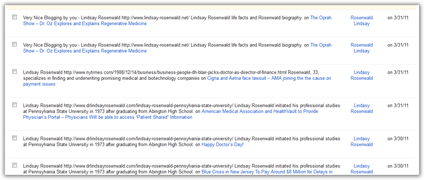
This page at Google Knol which will end on May of this year even has a Creative Commons License listed, pretty funny as splogs can have those too. SEO Services of course is one of the commenters here so those are his fans the SEO folks it seems:) Again I have just never seen anything so extensive and they must be working hard to justify their contract with Mr. Rosenwald. I have to say the algorithms that created these sure did use and re-use the same text to the maximum! It’s over here at the Knol site too, so blog platforms were not issue for the algorithms to cross with speed running bots at work.

There was actually one “real” press release from PRWeb buried in the splogs and I wonder why he doesn’t use avenues as such to promote himself instead of splogs? If you publish enough legitimate information out there the other stuff with age will go down the ranks. Link at the title below from March of 2011.
Lindsay Rosenwald: Biotechnologies Financial da Vinci
Once more it is amazing that a well known hedge fund manager would not know the difference here and is more comfortable with the Splog efforts.
One thing too about the web is that what may have been an effective tool yesterday, may not be so today and some Killer Algorithms here appear to be biting the Hedge Fund Manager. I happen to have a series on the Attacks of the Killer Algorithms that you may want to check out. I certainly was attacked by the Killer Algorithms here with spamming my blog and Mr. Rosenwald has them biting at his back too as they are getting to be just in the  way and not really serving a purpose any longer.
way and not really serving a purpose any longer.
Perhaps to his good news or maybe not so good news, this post will now be circulating and searched in Google and other browsers as well and perhaps it may even give Mr. Rosenwald ’s “splogs” some real competition for that top spot:)
So why did I do this story, that algorithm woke up and snuck in another spam comment! I was attached by the Killer Spamming Algorithms hired by a Hedge Fund who maybe didn’t have a clue on what he thought he was paying for. BD
Technorati Tags:
algoirthms,
mathmatics,
12 step addictions,
healthcare,
desired results,
rogue algorithm,
Charles Seife,
books,
numbers,
analytics,
journalism,
Google,
Rosenwald
 PDA before that to look up formularies. Even on this blog I put a courtesy search box for their web services to make it easy to look up a drug. The problem here is that they have way too much competition and the late start didn’t help them out a bit.
PDA before that to look up formularies. Even on this blog I put a courtesy search box for their web services to make it easy to look up a drug. The problem here is that they have way too much competition and the late start didn’t help them out a bit. 













 were current distributors of the raw material that makes the blood thinning drug. Back in October of 2010 it was back in the news again with another recall.
were current distributors of the raw material that makes the blood thinning drug. Back in October of 2010 it was back in the news again with another recall. 



 eClinical Works is an excellent EHR that is both web and client based and is used all over the US is connects with most hospital medical record systems and they have a big base of business but they are not a “corporate conglomerate” looking to feed hungry shareholders either.
eClinical Works is an excellent EHR that is both web and client based and is used all over the US is connects with most hospital medical record systems and they have a big base of business but they are not a “corporate conglomerate” looking to feed hungry shareholders either.  so they can get some data. I do wonder what CVS makes on selling data as the Walgreens SEC statement for 2010 said they made just under $800 million on selling data, that’s a lot of money.
so they can get some data. I do wonder what CVS makes on selling data as the Walgreens SEC statement for 2010 said they made just under $800 million on selling data, that’s a lot of money. 






















 way and not really serving a purpose any longer.
way and not really serving a purpose any longer.